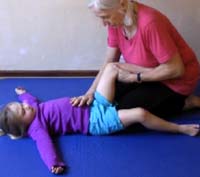Given normal, healthy joint surfaces, full range of movement depends on the extensibility and mobility of the soft tissue structures. This is particularly true of movements that require elongation of myo-fascial-neural (M-F-N) structures over more than one joint.
The basic technique
- In active mobilisation the limb segments are passively moved to a position where the target muscles and related fascial structures are lengthened (stretched).
- The limb position is then maintained by an external force (manual holding by the therapist) during several cycles of contraction – relaxation of the target and surrounding muscles.
- If the techniques is effective there will be an increase in the range of movement following the application of the active stretch.
- Stretching is followed by activities that involve the tight muscles in their lengthened range of movement.
Active mobilization to increase straight leg raise (SLR)
Structures that limit SLR include:
The structures limiting straight leg raise include: lumbodorsal fascial, gluteal fascia, iliotibial band, fascia lata, hamstring muscles and their related fascial extensions, neurovascular bundle related to the sciatic nerve.

The therapist holds the limb in this position and applies a longitudinal force along the long axis of the femur which stretches the shorter structures around the hip joint.
The therapist maintains the limb in this position for the duration of the cycle of contraction-relaxation of the target muscles.

